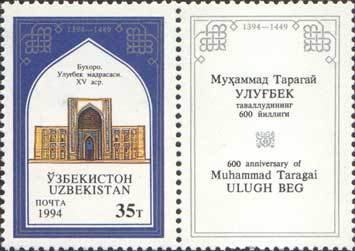Stamp with Attached Label: Ulugh Beg Mosque, Bukhara (Uzbekistan 1994)
Ulugh Beg Mosque, Bukhara (Uzbekistan 1994)
10 October (Uzbekistan ) within release 600th Birth Anniversary of Ulugh Beg goes into circulation Stamp with Attached Label Ulugh Beg Mosque, Bukhara face value 35 Uzbekistani tiyin
| Stamp with Attached Label Ulugh Beg Mosque, Bukhara in catalogues | |
|---|---|
| Michel: | Mi: UZ 47Zf |
Stamp with Attached Label is horizontal format.
Label. Text in English and Uzbek.Also in the issue 600th Birth Anniversary of Ulugh Beg:
- Stamp - Ulugh Beg mosque, Samarkand face value 30;
- Stamp - Ulugh Beg mosque, Bukhara face value 35;
- Stamp - Astronomical equipment face value 40;
- Stamp - Ulugh Beg statue, Tashkent face value 45;
- Souvenir Sheet - Portrait of Ulugh Beg (central Asian ruler) face value 60;
- Stamp - Portrait of Ulugh Beg (Central Asian Ruler) face value 60;
- Stamp with Attached Label - Ulugh Beg Mosque, Bukhara face value 35;
Stamp with Attached Label Ulugh Beg Mosque, Bukhara it reflects the thematic directions:
An anniversary is the date on which an event took place or an institution was founded in a previous year, and may also refer to the commemoration or celebration of that event. For example, the first event is the initial occurrence or, if planned, the inaugural of the event. One year later would be the first anniversary of that event. The word was first used for Catholic feasts to commemorate saints. Most countries celebrate national anniversaries, typically called national days. These could be the date of independence of the nation or the adoption of a new constitution or form of government. The important dates in a sitting monarch's reign may also be commemorated, an event often referred to as a "Jubilee".
Architecture (Latin architectura, from the Greek ἀρχιτέκτων arkhitekton "architect", from ἀρχι- "chief" and τέκτων "builder") is both the process and the product of planning, designing, and constructing buildings and other physical structures. Architectural works, in the material form of buildings, are often perceived as cultural symbols and as works of art. Historical civilizations are often identified with their surviving architectural achievements.
A building or edifice is a structure with a roof and walls standing more or less permanently in one place, such as a house or factory. Buildings come in a variety of sizes, shapes and functions, and have been adapted throughout history for a wide number of factors, from building materials available, to weather conditions, to land prices, ground conditions, specific uses and aesthetic reasons. Buildings serve several needs of society – primarily as shelter from weather, security, living space, privacy, to store belongings, and to comfortably live and work. A building as a shelter represents a physical division of the human habitat (a place of comfort and safety) and the outside (a place that at times may be harsh and harmful).
Mosquitoes, the Culicidae, are a family of small flies consisting of 3,600 species. The word mosquito (formed by mosca and diminutive -ito) is Spanish and Portuguese for little fly. Mosquitoes have a slender segmented body, one pair of wings, three pairs of long hair-like legs, and specialized, highly elongated, piercing-sucking mouthparts. All mosquitoes drink nectar from flowers; females of some species have in addition adapted to drink blood. The group diversified during the Cretaceous period. Evolutionary biologists view mosquitoes as micropredators, small animals that parasitise larger ones by drinking their blood without immediately killing them. Medical parasitologists view mosquitoes instead as vectors of disease, carrying protozoan parasites or bacterial or viral pathogens from one host to another.




